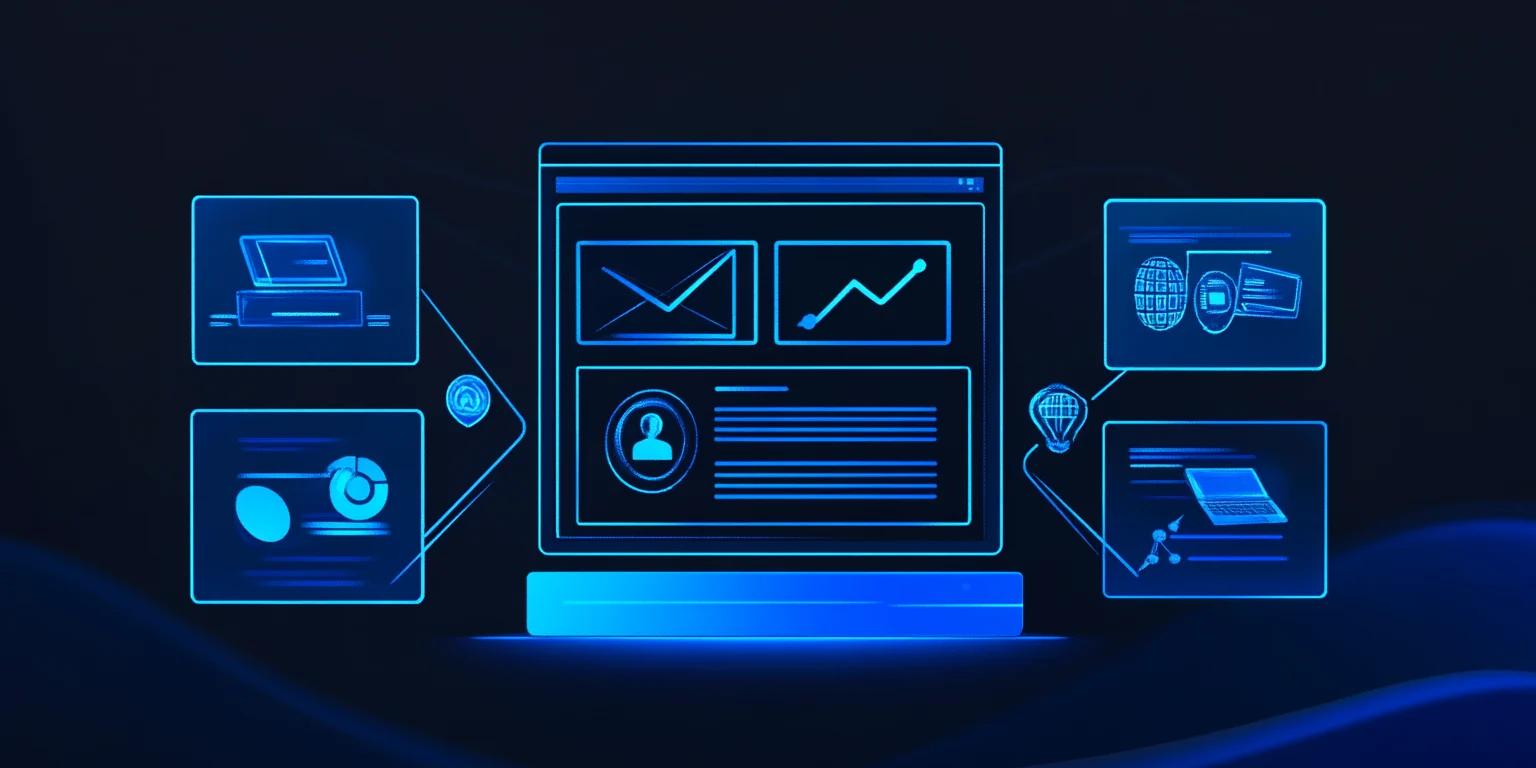This article will cover the benefits of SaaS web development, how it works, a comparison of SaaS vs traditional and the future of SaaS development.
Let’s get to it.
How Does SaaS Web Development Work?
If you’re worried about the complexity of managing web applications, SaaS web development offers a streamlined approach to building and maintaining web applications.
- Users access SaaS web apps via a web browser. This means you don't need to install any software on your local machine. Simply open your preferred browser, log in, and start using the application. This ease of access makes SaaS solutions highly convenient and user-friendly.
- The software and user's data are stored on the provider's remote servers. Instead of relying on your local storage, SaaS applications store everything on the cloud. This setup ensures that your data is secure and accessible from anywhere. You don't have to worry about losing data due to hardware failures or other local issues.
- Updates and maintenance are handled by the SaaS provider. One of the biggest advantages of SaaS is that you don't have to deal with software updates or maintenance tasks. The provider takes care of everything, ensuring that you always have access to the latest features and security patches. This hands-off approach allows you to focus on using the software rather than managing it.
- Subscription-based pricing model. SaaS typically operates on a subscription basis, where you pay a recurring fee to use the software. This model can be more cost-effective than traditional software purchases, as it often includes updates, support, and maintenance in the subscription fee. You can choose a plan that fits your needs and budget, making it a flexible option for businesses of all sizes.

Key Aspects of SaaS Web Development
Developing a successful SaaS application involves understanding and implementing several key components. By focusing on these elements, you can create applications that are scalable, secure, and user-friendly.
When developing a SaaS application, several key elements are crucial:
- Cloud-Based Architecture: Hosting your application in the cloud allows users to access it from any device with an internet connection, eliminating the need for local installations and simplifying maintenance.
- Multi-Tenancy Architecture: Designing your application to serve multiple customers from a single instance improves resource efficiency. Each user's data is securely separated within the shared infrastructure.
- Subscription-Based Model: Offering software through subscriptions provides flexibility for users and ensures recurring revenue.
- Customization and Integration: Allowing users to tailor the application to their needs enhances usability. Providing APIs for integration with other services enables seamless workflows.
Cloud-Based Architecture in SaaS
Cloud-based architecture is foundational for SaaS applications, offering several benefits:
- Accessibility: Users can access the application from anywhere, enhancing mobility and convenience.
- Scalability: Cloud services enable resource scaling based on demand, ensuring consistent performance as your user base grows.
- Cost Efficiency: Paying for only the resources you use can reduce infrastructure costs.
Benefits of Multi-Tenancy Architecture
Implementing a multi-tenancy architecture brings significant advantages:
- Resource Optimization: Sharing infrastructure among multiple tenants maximizes resource utilization.
- Simplified Maintenance: Updates and maintenance are performed centrally, so all users receive improvements without individual installations.
- Cost Reduction: Operating a single instance for multiple users lowers operational costs, which can lead to more affordable pricing for customers.
SaaS vs Traditional Web Development
Now let’s compare SaaS vs Traditional Web Development.
Updated Software
SaaS ensures you always have access to the latest software version. Traditional web development often requires manual updates and patches, which can be time-consuming and sometimes overlooked.
With SaaS, the provider handles all updates, ensuring your web application remains current with the latest features and security enhancements. This automatic update process eliminates the need for you to manage software versions, reducing the risk of running outdated or vulnerable software.
Easier Content Management
Integrated content management systems (CMS) in SaaS platforms simplify publishing. Traditional web development often involves complex CMS setups that require significant configuration and maintenance.
SaaS platforms offer built-in CMS solutions that are ready to use, allowing you to manage and publish content effortlessly. These systems often include user-friendly interfaces, making it easy for non-technical team members to update content, schedule posts, create newsletters and manage media files without needing extensive training or technical support.
Enhance Collaboration
Cloud-based access in SaaS platforms enables real-time collaboration from anywhere. Effective SaaS solutions page design can also facilitate better collaboration by making information more accessible. Traditional web development typically relies on local servers or limited remote access, which can hinder team collaboration.
SaaS platforms, on the other hand, are designed for cloud-based operation, allowing multiple users to work on the same project simultaneously from different locations. This real-time collaboration capability improves efficiency, as team members can see updates and changes instantly, reducing the need for back-and-forth communication and file sharing.
Caters Growing Needs
SaaS web apps can rapidly scale to accommodate growth. Whether you’re managing large-scale web operations or smaller ones, SaaS apps can take care of it all. Traditional web development often requires significant planning and resources to scale, including hardware upgrades and software reconfigurations.
SaaS platforms are built to scale effortlessly, allowing you to adjust resources based on your needs without worrying about infrastructure limitations. Whether you're experiencing a sudden spike in traffic or planning for long-term growth, SaaS platforms offer the flexibility to scale up or down quickly, ensuring your web application can handle increased demand without performance issues.

The Future of SaaS in Web Development
The landscape of SaaS web development continues to evolve, bringing new tools and technologies that simplify and enhance the development process. All this makes SaaS website redesign much easier. Here’s what you can expect in 2024 and beyond.
- No-code and low-code platforms will see continued growth. These platforms empower you to build web applications without extensive coding knowledge. Drag-and-drop interfaces and pre-built components make it easier to create functional and visually appealing websites. This democratizes web development, allowing more people to bring their ideas to life quickly and efficiently.
- AI and machine learning will automate more aspects of web development. These technologies can handle tasks like code generation, bug detection, and performance optimization. AI-driven tools can suggest design improvements, predict user behavior, and personalize content. This automation not only speeds up development but also enhances the quality and functionality of web applications.
- Serverless architecture will become more prevalent for effortless deployment and scaling. With serverless, you don’t need to manage servers or infrastructure. The cloud provider handles everything, allowing you to focus on writing code. Serverless applications can automatically scale to handle varying levels of traffic, ensuring your web app performs well under any load. This approach reduces operational complexity and costs, making it an attractive option for modern web development.
These trends indicate a future where SaaS web development becomes more accessible, efficient, and powerful. As these technologies mature, they will continue to transform how you build and manage web applications.
Benefits of SaaS for Web Development
Let’s dive into the specific benefits SaaS brings to web development.
SaaS Makes Web Development Easier
SaaS tools make quality web design more accessible to businesses of all sizes. Whether you run a small startup or a large enterprise, you can leverage SaaS platforms to create professional websites without needing extensive technical expertise. These tools often come with user-friendly interfaces and pre-built templates, allowing you to focus on your content and design rather than the underlying code.
If you’re unsure about the design of your SaaS website, go through the best B2B SaaS websites to get an idea of how they have utilized these tools effectively.
SaaS Gives Streamlined Design Workflow
Web builders speed up the design process by automating code generation. Traditional web development involves writing extensive lines of code, which can be time-consuming and prone to errors.
SaaS platforms simplify this by providing drag-and-drop functionalities and automated coding features. This means you can quickly prototype, test, and launch your website, reducing the overall development time. Incorporating advanced design elements like SaaS 3D designs can further enhance your site's visual appeal and user engagement.
SaaS Provides Advanced Features
SaaS enables the implementation of complex functionality without coding. Features like e-commerce integration, content management systems, and customer relationship management can be added with just a few clicks. The best CMS for SaaS companies often offers a wide range of plugins and extensions, allowing you to customize your website’s functionality to meet your specific needs without writing a single line of code.
Saas Platforms Are Extensible
Developers can create custom widgets and plugins to extend SaaS platforms. While SaaS tools offer a lot out of the box, they are also highly extensible. If you need a specific feature that isn’t available, you can develop custom widgets or plugins to add that functionality.
This flexibility ensures that you can tailor the platform to fit your unique requirements, making SaaS a versatile option for web development. Following SaaS website best practices can help you maximize the extensibility of your platform.

Is SaaS Web Development Right for Your Business?
SaaS web development offers a practical solution for many businesses, especially those without in-house web development resources. If you lack a dedicated team of developers, SaaS platforms can fill that gap. These tools provide user-friendly interfaces and pre-built templates, making it easier for you to create and manage your website without needing extensive technical skills.
Data security is a critical concern in SaaS web development. Since your data is stored on the provider's servers, you need to trust that they have robust security measures in place. Assess the provider's security protocols, data encryption standards, and compliance with industry regulations. Ensuring that your data is protected should be a top priority when considering a SaaS solution.
See the Webstacks Difference: Schedule a Brief Discovery Call Today. If you’re ready to transform your website into a powerful marketing tool, we’re here to help. Visit Webstacks to get started.




